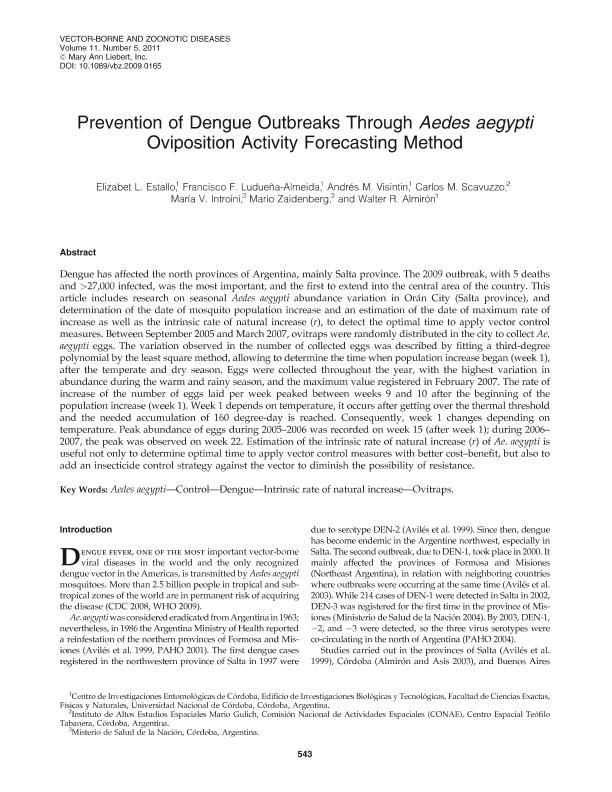Artículo
Prevention of dengue outbreaks through aedes aegypti oviposition activity forecasting method
Estallo, Elizabet Lilia ; Ludueña Almeida, Francisco; Visintin, Andrés Mario
; Ludueña Almeida, Francisco; Visintin, Andrés Mario ; Scavuzzo, Carlos Marcelo; Introini, María Virginia; Zaidenberg, Mario; Almiron, Walter Ricardo
; Scavuzzo, Carlos Marcelo; Introini, María Virginia; Zaidenberg, Mario; Almiron, Walter Ricardo
 ; Ludueña Almeida, Francisco; Visintin, Andrés Mario
; Ludueña Almeida, Francisco; Visintin, Andrés Mario ; Scavuzzo, Carlos Marcelo; Introini, María Virginia; Zaidenberg, Mario; Almiron, Walter Ricardo
; Scavuzzo, Carlos Marcelo; Introini, María Virginia; Zaidenberg, Mario; Almiron, Walter Ricardo
Fecha de publicación:
05/2011
Editorial:
Mary Ann Liebert
Revista:
Vector-borne And Zoonotic Diseases
ISSN:
1530-3667
e-ISSN:
1557-7759
Idioma:
Inglés
Tipo de recurso:
Artículo publicado
Clasificación temática:
Resumen
Dengue has affected the north provinces of Argentina, mainly Salta province. The 2009 outbreak, with 5 deaths and >27,000 infected, was the most important, and the first to extend into the central area of the country. This article includes research on seasonal Aedes aegypti abundance variation in Orán City (Salta province), and determination of the date of mosquito population increase and an estimation of the date of maximum rate of increase as well as the intrinsic rate of natural increase (r), to detect the optimal time to apply vector control measures. Between September 2005 and March 2007, ovitraps were randomly distributed in the city to collect Ae. aegypti eggs. The variation observed in the number of collected eggs was described by fitting a third-degree polynomial by the least square method, allowing to determine the time when population increase began (week 1), after the temperate and dry season. Eggs were collected throughout the year, with the highest variation in abundance during the warm and rainy season, and the maximum value registered in February 2007. The rate of increase of the number of eggs laid per week peaked between weeks 9 and 10 after the beginning of the population increase (week 1). Week 1 depends on temperature, it occurs after getting over the thermal threshold and the needed accumulation of 160 degree-day is reached. Consequently, week 1 changes depending on temperature. Peak abundance of eggs during 2005-2006 was recorded on week 15 (after week 1); during 2006-2007, the peak was observed on week 22. Estimation of the intrinsic rate of natural increase (r) of Ae. aegypti is useful not only to determine optimal time to apply vector control measures with better cost-benefit, but also to add an insecticide control strategy against the vector to diminish the possibility of resistance.
Palabras clave:
Aedes Aegypti
,
Control
,
Dengue
,
Intrinsic Rate of Natural Increase
,
Ovitraps
Archivos asociados
Licencia
Identificadores
Colecciones
Articulos(IIBYT)
Articulos de INSTITUTO DE INVESTIGACIONES BIOLOGICAS Y TECNOLOGICAS
Articulos de INSTITUTO DE INVESTIGACIONES BIOLOGICAS Y TECNOLOGICAS
Citación
Estallo, Elizabet Lilia; Ludueña Almeida, Francisco; Visintin, Andrés Mario; Scavuzzo, Carlos Marcelo; Introini, María Virginia; et al.; Prevention of dengue outbreaks through aedes aegypti oviposition activity forecasting method; Mary Ann Liebert; Vector-borne And Zoonotic Diseases; 11; 5; 5-2011; 543-549
Compartir
Altmétricas



